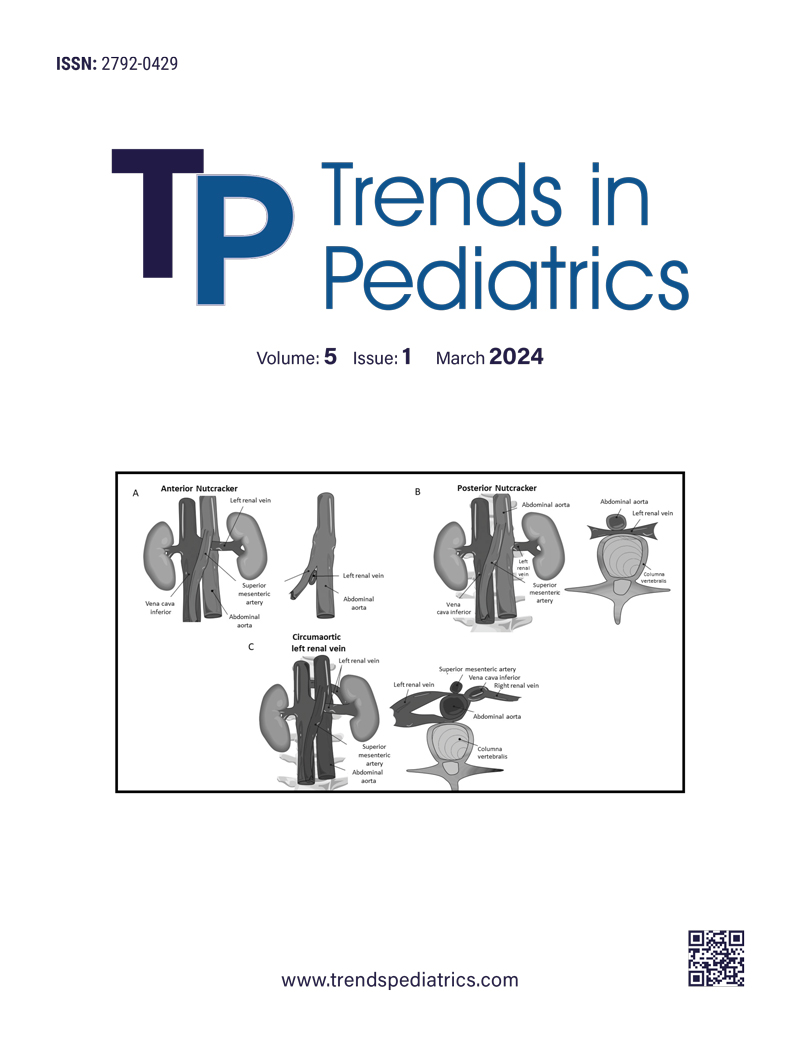Abstract
Objectives: Urinary system infections (UTIs) are among the most common infections affecting the pediatric age group. We aim to show the distribution of pathogenic microorganisms and antimicrobial resistance patterns of urinary tract infections (UTIs) and select the most appropriate antibiotherapy in the pediatric age group. Also, we wanted to determine signs and symptoms, predisposing factors, and imaging findings in UTIs.
Material and Methods: In this study, the Elazığ Fethi Sekin City Hospital health registry system was screened retrospectively to obtain data about the results of urinalysis, urine culture tests, and urinary imaging findings of patients, who presented to the pediatric nephrology clinic with signs and symptoms of UTI between January 2020 and September 2021. The study population consisted of children aged 1 month to 18 years.
Results: The study sample included 191 patients. Antimicrobial resistance of E. coli was seen at the highest level to ampicillin (55%), followed by amoxicillin (42%), trimethoprim-sulfamethoxazole (TMP-SMX) (36%), and cefuroxime (35%). The antimicrobial resistance of Klebsiella pneumoniae was seen most frequently in patients treated with ampicillin (100%), amoxicillin (50%), ceftazidime (31%), and nitrofurantoin (31%). The antimicrobial resistance of Proteus mirabilis was seen mostly in cases that received nitrofurantoin (88%), and TMP-SMX (55%). Enterobacter aerogenes demonstrated minimal antimicrobial sensitivity to ampicillin (66%), amoxicillin (33%), and nitrofurantoin (33%) in decreasing order of frequency.
Conclusions: The rate of resistance to ampicillin is very high in Klebsiella pneumoniae and in Enterobacter spp and rates of antimicrobial resistance to cephalosporin, TMP-SMX, and nitrofurantoin are increasing. The rational use of antibiotics is a globally important issue.
Keywords: Antimicrobial resistance, children, urinary tract infection, uropathogens
References
- Urinary tract infection in under 16s: diagnosis and management. London: National Institute for Health and Care Excellence (NICE); July 27, 2022.
- Larcombe J. Urinary tract infection in children: recurrent infections. BMJ Clin Evid. 2015;2015:0306.
- Tullus K, Shaikh N. Urinary tract infections in children. Lancet. 2020;395:1659-68. https://doi.org/10.1016/S0140-6736(20)30676-0
- Roberts KB, Wald ER. The Diagnosis of UTI: Colony Count Criteria Revisited. Pediatrics. 2018;141:e20173239. https://doi.org/10.1542/peds.2017-3239
- Mattoo TK, Shaikh N, Nelson CP. Contemporary Management of Urinary Tract Infection in Children. Pediatrics. 2021;147:e2020012138. https://doi.org/10.1542/peds.2020-012138
- Ammenti A, Alberici I, Brugnara M, et al. Updated Italian recommendations for the diagnosis, treatment and follow-up of the first febrile urinary tract infection in young children. Acta Paediatr. 2020;109:236-47. https://doi.org/10.1111/apa.14988
- Ahmed M, Long WNW, Javed S, Reynolds T. Rising resistance of urinary tract pathogens in children: a cause for concern. Ir J Med Sci. 2022;191:279-82. https://doi.org/10.1007/s11845-021-02531-4
- Samancı S, Çelik M, Köşker M. Antibiotic resistance in childhood urinary tract infections: A single-center experience. Turk Pediatri Ars. 2020;55:386-92. https://doi.org/10.14744/TurkPediatriArs.2020.22309
- Yakubov R, van den Akker M, Machamad K, Hochberg A, Nadir E, Klein A. Antimicrobial Resistance Among Uropathogens That Cause Childhood Community-acquired Urinary Tract Infections in Central Israel. Pediatr Infect Dis J. 2017;36:113-5. https://doi.org/10.1097/INF.0000000000001373
- Esposito S, Biasucci G, Pasini A, et al. Antibiotic Resistance in Paediatric Febrile Urinary Tract Infections. J Glob Antimicrob Resist. 2022;29:499-506. https://doi.org/10.1016/j.jgar.2021.11.003
- Marcus N, Ashkenazi S, Samra Z, Cohen A, Livni G. Community-acquired enterococcal urinary tract infections in hospitalized children. Pediatr Nephrol. 2012;27:109-14. https://doi.org/10.1007/s00467-011-1951-5
- Yolbaş I, Tekin R, Kelekci S, et al. Community-acquired urinary tract infections in children: pathogens, antibiotic susceptibility and seasonal changes. Eur Rev Med Pharmacol Sci. 2013;17:971-6.
- Dayan N, Dabbah H, Weissman I, Aga I, Even L, Glikman D. Urinary tract infections caused by community-acquired extended-spectrum β-lactamase-producing and nonproducing bacteria: a comparative study. J Pediatr. 2013;163:1417-21. https://doi.org/10.1016/j.jpeds.2013.06.078
- Tanaka Y, Oishi T, Ono S, et al. Epidemiology of urinary tract infections in children: Causative bacteria and antimicrobial therapy. Pediatr Int. 2021;63:1198-204. https://doi.org/10.1111/ped.14639
- The European Committee on Antimicrobial Susceptibility Testing. Breakpoint tables for interpretation of MICs and zone diameters. Version 9.0, 2019. Available at: https://www.eucast.org/fileadmin/src/media/PDFs/EUCAST_files/Breakpoint_tables/v_9.0_Breakpoint_Tables.pdf
- Lugg-Widger FV, Angel L, Cannings-John R, et al. Long-term outcomes of urinary tract infection (UTI) in Childhood (LUCI): protocol for an electronic record-linked cohort study. BMJ Open. 2019;9:e024210. https://doi.org/10.1136/bmjopen-2018-024210
- Simões E Silva AC, Oliveira EA, Mak RH. Urinary tract infection in pediatrics: an overview. J Pediatr (Rio J). 2020;96(Suppl 1):65-79. https://doi.org/10.1016/j.jped.2019.10.006
- Çoban B, Ülkü N, Kaplan H, Topal B, Erdoğan H, Baskın E. Five-year assessment of causative agents and antibiotic resistances in urinary tract infections. Turk Pediatri Ars. 2014;49:124-9. https://doi.org/10.5152/tpa.2014.1505
- Moya-Dionisio V, Díaz-Zabala M, Ibáñez-Fernández A, et al. Uropathogen pattern and antimicrobial susceptibility in positive urinary cultures isolates from paediatric patients. Rev Esp Quimioter. 2016;29:146-50.
- Gürgöze MK, Doğan Y, Kizirgil A, Aşçı Toraman Z, Aygün D. Antimicrobial sensitivities of bacteria isolated from urinary tract infections in children. Fırat Medical Journal. 2002;7:828-32.
- Koçak M, Büyükkaragöz B, Çelebi Tayfur A, et al. Causative pathogens and antibiotic resistance in children hospitalized for urinary tract infection. Pediatr Int. 2016;58:467-71. https://doi.org/10.1111/ped.12842
- Nji CP, Assob JCN, Akoachere JTK. Predictors of Urinary Tract Infections in Children and Antibiotic Susceptibility Pattern in the Buea Health District, South West Region, Cameroon. Biomed Res Int. 2020;2020:2176569. https://doi.org/10.1155/2020/2176569
- Ganesh R, Shrestha D, Bhattachan B, Rai G. Epidemiology of urinary tract infection and antimicrobial resistance in a pediatric hospital in Nepal. BMC Infect Dis. 2019;19:420. https://doi.org/10.1186/s12879-019-3997-0
- Vazouras K, Velali K, Tassiou I, et al. Antibiotic treatment and antimicrobial resistance in children with urinary tract infections. J Glob Antimicrob Resist. 2020;20:4-10. https://doi.org/10.1016/j.jgar.2019.06.016
- Beetz R, Westenfelder M. Antimicrobial therapy of urinary tract infections in children. Int J Antimicrob Agents. 2011;38(Suppl):42-50. https://doi.org/10.1016/j.ijantimicag.2011.09.006
Copyright and license
Copyright © 2024 The author(s). This is an open-access article published by Aydın Pediatric Society under the terms of the Creative Commons Attribution License (CC BY) which permits unrestricted use, distribution, and reproduction in any medium or format, provided the original work is properly cited.














